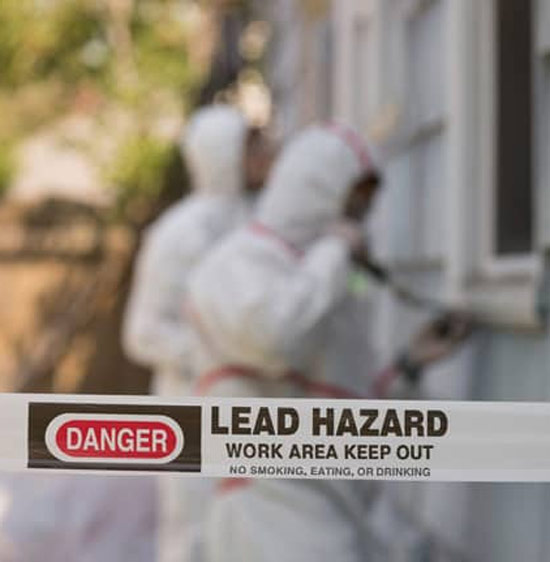Vital Tools and Techniques for Effective Lead Violation Cleanup
Addressing lead infractions effectively requires a comprehensive technique that mixes the right tools with critical approaches. Simultaneously, the use of specialized clean-up devices, such as HEPA vacuums and lead-specific cleansing representatives, is crucial for thorough pollutant elimination. Effective containment approaches, including plastic sheet and adverse air pressure systems, are vital to stop the spread of hazardous materials.
Personal Safety Tools
Personal protective devices (PPE) is an essential component in the efficient administration of lead contamination cleaning. PPE functions as a vital barrier, protecting employees from the harmful results of lead direct exposure, which can result in severe health consequences. The necessary PPE for lead cleaning consists of respirators, safety apparel, handwear covers, and eye defense. Each kind of equipment is specifically designed to mitigate different risks related to lead particles and dust.
Respirators, especially those equipped with HEPA filters, are indispensable for filtering system airborne lead fragments, stopping inhalation. Safety clothes, consisting of coveralls and disposable matches, stops lead dust from sticking to workers' garments, minimizing the danger of second contamination.
Additionally, rigorous training on the right usage and upkeep of PPE is important. Employees need to be educated on putting on and doffing procedures to prevent contamination. Regular assessments and replacements of PPE elements are necessary to preserve their safety abilities, making certain a safe and certified cleanup procedure.
Specialized Clean-up Devices

One more crucial tool is the wet/dry vacuum, which can properly clean up both dust and fluid contaminants. These vacuums commonly come with HEPA filters to offer an extra layer of safety. Wet cleans or tack cloths are also vital for surface area cleansing; they are especially developed to record and hold lead bits, lowering the risk of spreading out contamination.
For even more persistent down payments, specialized lead-removal cleaner are required. These agents are developed to break down lead bits, making them less complicated to get rid of. Scrub brushes with sturdy bristles can aid in this process, particularly on rough surfaces where lead dust has a tendency to adhere a lot more highly.
Additionally, encapsulants are used to seal lead-contaminated surfaces, preventing the release of lead dust. These specialized paints and coverings are developed to stick to different substrates, offering a long-term service for lead control.
Effective Control Approaches
Effective control techniques are essential in mitigating the spread of lead contamination throughout clean-up tasks. Carrying out robust control techniques ensures that lead fragments do not migrate to untouched areas, therefore securing both workers and the setting (DOH & HPD Lead Violation Removal NYC).

To boost containment, encapsulants can be related to surfaces that are not being eliminated or disrupted. straight from the source These specialized coverings bind lead dirt, lowering its schedule for resuspension. Additionally, all employees should wear proper Personal Protective Tools (PPE), including respirators and non reusable fits, to stop contamination spread.
Safe Disposal Practices
Making certain safe disposal methods is an important part in the management of lead contamination clean-up. Appropriate disposal minimizes the risk of lead re-entering the atmosphere and threatening public wellness (DOH & HPD Lead Violation Removal NYC).
Transporting lead waste requires adherence to strict guidelines. Utilizing accredited unsafe waste carriers ensures that the materials are dealt with properly. Paperwork, consisting of materializes describing the kind and amount of waste, must go along with deliveries to track the waste from the website of beginning to its final disposal destination.
Designated contaminated materials disposal facilities are geared up to deal with lead-contaminated materials safely. These facilities often employ advanced approaches such as stablizing, solidification, or chemical therapy to reduce the effects of the lead prior to disposal. Landfilling in specialized, lined areas that avoid leachate from contaminating groundwater is a common technique for last disposal.
Routine training for workers involved in lead waste disposal is critical to keep security requirements and prevent accidental direct exposure. By adhering to these practices, companies can substantially decrease the environmental and wellness effects associated with lead contamination.
Regulatory Conformity Tips

Complying with regulative compliance is extremely important in the successful implementation of lead contamination clean-up. Understanding and following government, state, and regional regulations makes sure not only the safety and wellness of individuals yet likewise the lawful and financial health of the cleanup company. The Environmental Security Firm (EPA) sets rigorous standards, such as the Lead Improvement, Repair Work, and Paint (RRP) Guideline, which mandates correct certification and training for specialists handling lead-based activities.
Conformity starts with a thorough assessment of suitable regulations and regulations. Organizations should stay upgraded on any kind of legal changes, which can be helped with with routine training sessions and signing up for sector updates. Documents is an additional crucial compliance aspect; preserving in-depth documents of all tasks, consisting of assessment records, staff member training logs, and disposal shows up, is crucial.
Moreover, involving with licensed lead assessors or take the chance of assessors ensures that lead hazards are appropriately recognized and minimized. Companies have to apply making use of Individual Protective Equipment this contact form (PPE) and guarantee that safety protocols are purely adhered to. Finally, transparent communication with stakeholders, including staff members, customers, and regulative bodies, will foster a society of conformity and responsibility, ultimately contributing to a more Related Site secure and a lot more effective lead cleanup procedure.
Verdict
Efficient lead infraction cleaning necessitates the combination of specialized devices and tactical methods to make certain safety and efficacy. Individual protective devices (PPE) safeguards employees from direct exposure, while safe disposal methods and stringent adherence to regulatory conformity are important for properly handling harmful waste.